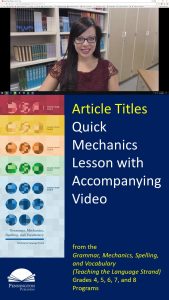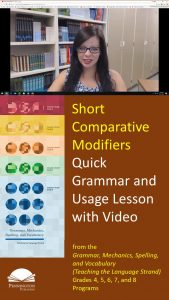Punctuation of Article Titles
Punctuation of Article Titles
Play the quick video lesson HERE and click the upper left back arrow to return to this lesson.
Common Core Language Standard 2
Articles appear in many forms of media. Blogs, magazines (both print and online), encyclopedias, newspapers, and journals all have articles.
Today’s mechanics lesson is on how to punctuate article titles. Remember that we underline or italicize the titles of newspapers, magazines, and website titles.
Now let’s read the mechanics lesson and study the examples.
Place quotation marks before and after the titles of articles. Articles are parts of whole things, small things, or things that can’t be picked up from a table. An article is a short written work such as a newspaper article, magazine article, or blog article that is part of the larger publication. Example: “The President’s Greatest Challenge”
Now circle or highlight what is right and revise what is wrong according to mechanics lesson.
Practice: She went to the store to buy the Popstar! magazine, so she could read the article titled “Don’t Marry in Hollywood.
Let’s check the Practice Answers.
Mechanics Practice Answers: She went to the store to buy the Popstar! magazine, so she could read the article titled “Don’t Marry in Hollywood.”
Now let’s apply what we have learned.
Writing Application: Write your own sentence using the title of a newspaper and a newspaper article.
*****

Pennington Publishing Grammar Programs
Teaching Grammar, Usage, and Mechanics (Grades 4, 5, 6, 7, 8, and High School) are full-year, traditional, grade-level grammar, usage, and mechanics programs with plenty of remedial practice to help students catch up while they keep up with grade-level standards. Twice-per-week, 30-minute, no prep lessons in print or interactive Google slides with a fun secret agent theme. Simple sentence diagrams, mentor texts, video lessons, sentence dictations. Plenty of practice in the writing context. Includes biweekly tests and a final exam.
Grammar, Usage, and Mechanics Interactive Notebook (Grades 4‒8) is a full-year, no prep interactive notebook without all the mess. Twice-per-week, 30-minute, no prep grammar, usage, and mechanics lessons, formatted in Cornell Notes with cartoon response, writing application, 3D graphic organizers (easy cut and paste foldables), and great resource links. No need to create a teacher INB for student make-up work—it’s done for you! Plus, get remedial worksheets, biweekly tests, and a final exam.
Syntax in Reading and Writing is a function-based, sentence level syntax program, designed to build reading comprehension and increase writing sophistication. The 18 parts of speech, phrases, and clauses lessons are each leveled from basic (elementary) to advanced (middle and high school) and feature 5 lesson components (10–15 minutes each): 1. Learn It! 2. Identify It! 3. Explain It! (analysis of challenging sentences) 4. Revise It! (kernel sentences, sentence expansion, syntactic manipulation) 5. Create It! (Short writing application with the syntactic focus in different genre).
Get the Diagnostic Grammar, Usage, and Mechanics Assessments, Matrix, and Final Exam FREE Resource:
![]()










